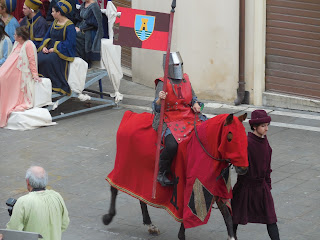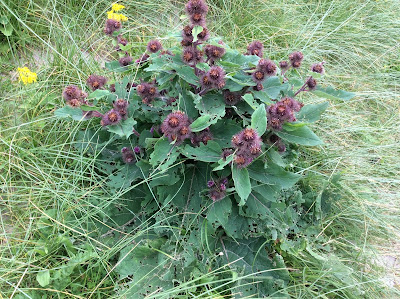And escape it we did! In 27 days in Scotland, only 5 were rain-free, and the highest temperature of the month was a blistering 62 degrees, with the average down around 52. Exactly what we were looking for after Tuscany's summer long heat wave with temperatures routinely topping 100 degrees.
We started in Glasgow where the hop on hop off bus (recommended by local boy Rick Steves) proved amazingly useful. Glasgow is an interesting city with friendly albeit difficult to understand residents. Even people from other parts of Scotland have trouble understanding the Glaswegian accent. We regretted having only 3 days here, but made the most of them.
 |
| Tom enjoys his first 'fry' of the trip |
 |
| hop on bus |
 |
| Kelvingrove museum |
 |
| \Nancy and Elvis at the Kelvingrove |
 |
| steak pie and mushy peas at the diner |
 |
female bagpipe player at
dockside wedding |
 |
| Dali's famous St. John of the Cross crucifixion |
 |
mural of rock stars above left, Tom and
friend at the transportation museum above |
We picked up a car at Glasgow airport and headed to the coast, first stop Oban and a trip to the isles of Mull and Iona. We stayed overnight in Oban, a nice town, but if I was doing the trip again I would stay on Iona which is a beautiful little island with some interesting old buildings. St. Columba, an Irish bishop, had a monastery built on Iona around the 6th century, which has been extensively restored, and is beautifully positioned on the coast.
 |
The seafood was, indeed, excellent
|
 |
Highland cattle on Mull, they need the long shaggy
coasts to survive the cold island winter (and summer) |
It is a 10 minute ferry ride from Mull to Iona to see the ruins of a nunnery and St. Columba's monastery.
 |
| the ruins of a nunnery (above) monastery & church below |
From Oban, it is a pleasant drive to the Isle of Skye, via Glencoe, an area known for the massacre of Glencoe, but also recently voted the 'most romantic glen in Scotland.' 38 members of the MacDonald clan were murdered at Glencoe by King William III's forces after the 'glorious revolution.' The King intended to wipe out the entire clan, but most escaped into the mountains. We also visited Loch Lomond, not far from Glasgow, stopping at Luss, considered one of the prettiest villages in Scotland.
 |
| At Glencoe visitor center (above) view of part of the glen, below |
 |
| typical Luss cottage |
 |
| 90 minute boat ride on loch lomond |
From Loch Lomond, it is only a couple of hours to Skye via the bridge at Kyle of Lochalsh. Just before the bridge is the Eileen Donan castle, the most photographed castle in Scotland according to the locals.
We spent a week on Skye in Drummuie cottage, a cozy place to retreat to when the wind and rain got too severe. Skye was formed by glaciers and is very rocky and dramatic with dozens of lakes and hills. There are more sheep than people ever since the "clearances" in the 18th century when the Brits moved the islanders off the west coast to the rocky and barren east coast of the island so the Brits could have better property for shooting grouse and for their own sheep.
 |
| Kilt rock |
 |
Black house (replica of thatched cottage). In the 1800s they started building
the little white houses seen everywhere. The black houses go back centureis. |
 |
| Fairy glen |
 |
| Portree on Skye |
 |
| typical isolated croft (small farm) |
 |
| heather blooms everywhere in Scotland |
 |
Dunvegan castle (according to Tom, the place where ex-vegetarians retire)
|

 |
| sunset from the cabin |
 |
| Uig, on Skye |
Next stop, Harris and Lewis. In reality they are one island but have long been treated as separate. We stayed in a B& in Luskentyre, a 7 house village by one of the white sandy beaches for which the islands are well known (at least in Scotland). In addition to checking out the scenery, we visited several Harris tweed places, culminating in a visit to Donald John, who worked out of a tin hut 2 doors down from our B&B. He was really hospitable, telling us about making tweed since he was 13 (when I asked if he had being doing it all his life he said, "Well, not yet."), showing us how the foot pedal loom worked, and then showing us the fabric he was making for Chanel and the layouts for the clothes Chanel was making with his tweed. He also showed us tweed nikes made from his tweed. When we got back to the B&B they told us he had an OBE!
 |
Donald John in front of some of his work, the nike tweed shoe (center) and
demonstrating the foot pedal loom, working on an order for Chanel
|
Lewis is home to several prehistoric sites, including the Callendish Stones, Scotland's answer to Stonehenge (and older than Stonehenge as they are quick to point out). Standing stones, large rocks set on end, are scattered throughout Scotland and are believed to have served some religious purpose.
We also drove across a very narrow bridge (labelled 'weak bridge' which is not very reassuring) to a small island where an iron age village was found under the sand. After excavation it was reburied to preserve it, but there is one reconstructed house open for visitors.
 |
| narrow bridge left,e house iron age housvee abo |
From Uig on Lewis, it was a bumpy 3 hour ferry ride to Ullapool, where we stayed at our favorite B&B of the trip. The room was nice but it was Colleen and Richard, the hosts, who made it so great. We did their recommended "perfect day out", not forgetting to stop for pie at their recommended spot.
 |
| Taking back steak and ale pies for Richard and Colleen |
 |
| abandoned castle near Ullapool |
 |
| West House B&B |
 |
| Bridge to the Gorge |
On to Inverness, via the infamous Loch Ness. We actually stopped at the Loch Ness visitor center for a fairly interesting presentation on the history of the myth and the science of the lake, then went on to Urguhart castle, the best spot for viewing the lake. No Nessie sightings, but it was a beautiful day for a stroll around the castle grounds.
 |
| Loch Ness and part of the castle |
The Culloden battlefield is also a short drive from Inverness. The battle, which lasted less than an hour, spelled the end of the Jacobite's attempts to reclaim the throne for Bonnie Prince Charlie. 1500 Jacobites, mostly Highland Scots, died while only 50 government troops perished. Today, it is a peacful moor, covered with flowers, a memorial to the dead, and stones marking the mass graves of the clans. A high tech visitors center provides more than ample information about the conflict and the history leading up to it, including a 4 minute film of the battle intended to make you feel like you are in the middle of the charge.
 |
| Culloden field (above) replica of house on Culloden field (below) |
 |
| Clava Cairns, a prehistoric cemetary near Culloden, about 4000 years old |
Our final stop was Edinburgh, a city recently named the most friendly city in the world by Conde Nast. Our experiences back s up that claim, the people were open and helpful, offering assistance from cell phones to directions without being asked. The residents clearly love their city and assume that you will enjoy it just as much. A cabbie asked me if I would be moving to Edinburgh now that I had seen it, obviously expecting an affirmative answer.
We stayed in a great apartment on the divide between new and old town, walking distance to many of the places we wanted to see. While 5 days aren't enough to see everything the city has to offer, we managed to see a lot (for us), from walking through the Prince Street Gardens to the Castle then back down the Royal Mile past St. Giles and other spots of interest, the National Museums, Haymarket, and more.
 |
| Edinburgh castle from Prince Street Gardens |
 |
| Edinburgh is the first UNESCO city of literature |
 |
| at the castle |
 |
| High tea before... |
 |
| High tea during... |
 |
high tea after!
|
 |
| Views of the skyline from the National museum roof garden |
 v v |
exhibits at National Gallery, the actual
"beheader" above, and Bonnie Prince
Charlie's cradle (below) |
Because of the unusually wet and cold summer (unusual even for Scotland), flowers were blooming everywhere, We end with a selection of flower pictures (believe me there could be a lot more)/ Slainte.
 |
blooming by the iron age house
|





















































































































